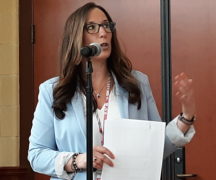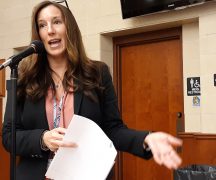By JAN LARSON McLAUGHLIN
BG Independent News
So much for stiff, hard-backed chairs in this Crim classroom. The students in Amy Kenyon’s fifth grade had enough of the uncomfortable traditional seats. They wanted flexibility – and they took action to get it.
“I read an article about it,” Chasey Walker said. “So I started a petition.”
“It helps us concentrate more,” another student chimed in.
“Most definitely,” Dylan Krupp said.
It all began when students in Kenyon’s language arts classroom were working on non-fiction reading and opinion writing. They took their lesson a step further.
“We’ve made a petition,” they informed Kenyon.
“And I thought – oh no,” their teacher said.
Kenyon advised the students that their petition would need to be backed up by an essay.
“This group then grows,” Kenyon said of the students pushing for flexible seating.
Maddy Baldonado and Isa Wan started working on a persuasive essay, while Dylan began researching the costs of non-traditional seating.
“I was stuck,” Kenyon said with a big grin. “I can’t tell them not to research.”
The students even recruited Isabella Nardone, from another classroom, to help their cause.
“They bring her in because she’s really good with words,” Kenyon said.
The students researched the value of flexible seating, which allows kids to fidget and use up energy that builds up if they are forced to sit still in rigid chairs.
Kenyon agreed that some students’ brains work better when their bodies are moving.
“As long as the students are working, they can be comfortable,” she said.
The students were so committed, they used free time on their mission to get a grant for flexible seating.
“They worked on it on their own time, before school, during recess, they ate lunch in class,” Kenyon said.

Students use flexible seating in Amy Kenyon’s classroom.
Dylan’s research turned up all kinds of non-traditional seating – bungee cord chairs that allow children to sink into a web of stretchy cords, wobble stools that give kids the ability to wiggle around, standing “stability discs” that allow kids to wobble, camp chairs, stools low to the floor, bouncy bands under desks that allow for foot movement, and even bicycle pedals under a desk.
“I was so impressed,” Kenyon said of their dedication.
Then came the next step. The students had to present their proposal to interim Principal Gary Keller.
“He thought it was really good,” Kenyon said. “I almost cried. They were so good.”
Then came an even bigger trial. They had to present their case to Superintendent Francis Scruci.
The young activists made their pitch.
“You’re fidgeting in class and just want to get out of this hard plastic chair,” their presentation began. “Kids sometimes can’t focus and want to mess around during class. They need a break in school. Flexible seating allows kids to be focused and to be comfy.”
“An uncomfortable student is a distracted and unproductive student,” the students said.
They compared uncomfortable seating to an empty stomach. “As the countdown to lunch approaches, the sound of his or her growling stomach will make it impossibly hard to hear the teacher’s voice. An uncomfortable chair can have the same effect.”
Scruci was suitably impressed.
“Francis looked at them and said, ‘You have a voice. I want to hear your voice for the remainder of your years here,’” Kenyon recalled.
The students also presented a survey they conducted among fifth graders, and fourth graders – since they would inherit the flexible seating next year.
Out of the 69 fifth graders surveyed, 97 percent were in favor of flexible seating. Fourth graders were 98 percent in favor.
The students got Scruci’s blessing and applied for a $1,000 grant from the Bowling Green School Foundation. The grant was approved in full.
“I was so excited for them,” Kenyon said, giving the students full credit for their success. “I simply supported and encouraged.”
That grant didn’t cover everything on their flexible seating wish list. So the students put a request on DonorsChoose.org, and received another $522.31.
“The kids chose exactly what they wanted – with the couch and bean bag chair still to be delivered.
As the flexible seating arrived, the students moved their traditional chairs and desks out of the classroom.
“These students feel empowered. They are excited,” Kenyon said. “It’s amazing. I’m so proud of these kids.”
Kenyon admitted that she wasn’t sure about the wide variety of seating at first.
“This is not my comfort zone. They took me out of my comfort zone – but what could I say?”
Kenyon is already seeing some positive results from the flexible seating, especially for “popcorning kids” who need movement.
“Students don’t leave the room as much. They are able to get their work done,” she said.
The kids agreed.
“A lot of us are getting better grades on tests,” one student said.
“And misbehaviors have gone down,” along with noise levels in the classroom, another added.
“We’re just collaborating” not goofing around, a fifth grader explained.
Kenyon is now wondering what is next for these innovative kids. She has started a “genius hour” each week in class to allow the students to create, discover, fail, and start the process all over again.
The kids are working on projects like how to make the world a kinder place, and how to sell slime.
“What is next year going to bring,” Kenyon asked with another grin.
Her kids agree – this is just the beginning for them.
“This could expand further than this class. I’d like to see that,” Dylan said.
The fifth graders are planning to get together in the summertime to work on further ideas.
“This is more than just chairs,” Reagan Hofmann said.
“We’re the type of people who could be great for the future,” Isabella said.




